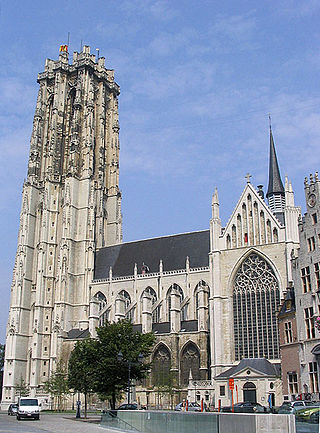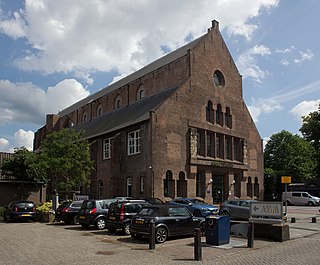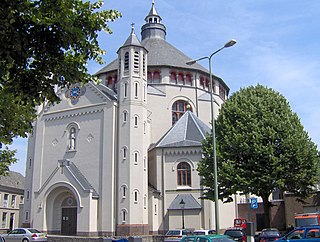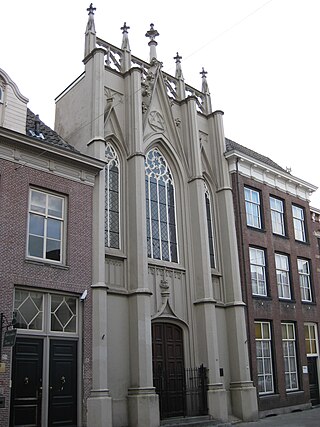
Hieronymus Bosch was a Dutch painter from Brabant. He is one of the most notable representatives of the Early Netherlandish painting school. His work, generally oil on oak wood, mainly contains fantastic illustrations of religious concepts and narratives. Within his lifetime, his work was collected in the Netherlands, Austria, and Spain, and widely copied, especially his macabre and nightmarish depictions of hell.

's-Hertogenbosch, colloquially known as Den Bosch, is a city and municipality in the Netherlands with a population of 160,783. It is the capital of the province of North Brabant and its fourth largest city by population. The city is south of the Maas river and near the Waal.

North Brabant, also unofficially called Brabant, is a province in the south of the Netherlands. It borders the provinces of South Holland and Gelderland to the north, Limburg to the east, Zeeland to the west, and the Flemish provinces of Antwerp and Limburg to the south. The northern border follows the Meuse westward to its mouth in the Hollands Diep strait, part of the Rhine–Meuse–Scheldt delta. North Brabant had a population of about 2,626,000 as of January 2023. Major cities in North Brabant are Eindhoven, Tilburg, Breda, its provincial capital 's-Hertogenbosch, and Helmond

The Catholic Cathedral Church of St. John (Sint-Janskathedraal) of 's-Hertogenbosch, North Brabant, is the height of Gothic architecture in the Netherlands. It has an extensive and richly decorated interior, and serves as the cathedral for the bishopric of 's-Hertogenbosch.

Terheijden is a village in the Dutch province of North Brabant. It is located in the municipality of Drimmelen, about 6 km north of Breda.
Brabants Dagblad is a daily Dutch newspaper. It is distributed in the center and northeast of North Brabant, in 's-Hertogenbosch and Tilburg and their surrounding regions. The paper's office is in 's-Hertogenbosch.

Brabantine Gothic, occasionally called Brabantian Gothic, is a significant variant of Gothic architecture that is typical for the Low Countries. It surfaced in the first half of the 14th century at St. Rumbold's Cathedral in the city of Mechelen.

Raamsdonksveer is a town in the Dutch municipality of Geertruidenberg, North Brabant. It lies on the east side of the Donge opposite Geertruidenberg. It is a regional center of commerce and industry. Raamsdonksveer lies between Oosterhout and Hank
The following is a timeline of the history of the municipality of 's-Hertogenbosch, Netherlands.

Het Noordbrabants Museum is an art museum in 's-Hertogenbosch, Netherlands.
Jheronimus Bosch—Visions of Genius was a 2016 art exhibition at the Noordbrabants Museum in 's-Hertogenbosch, the Netherlands, about the work of Hieronymus Bosch, a native of 's-Hertogenbosch.

Bokhoven Castle was a big defendable castle in Bokhoven, the Netherlands. A moat and part of the northern wall of the outer bailey are all that reminds of the castle.

The Swan Brothers' House in 's-Hertogenbosch is a museum and the home of a famous medieval confraternity.

The Big Arsenal, in Dutch: Groot Tuighuis, in 's-Hertogenbosch, Netherlands, is also known as Old St. James Church, or Oude Sint Jacobskerk. It is the former location of the Noordbrabants Museum. It now houses the municipal heritage department and its storage. It is open to visitors four days a week.

St. Catherine's Church, in Dutch Sint-Catharinakerk was previously named Cross Church, Kruiskerk or Kruisherenkerk and is located at the Kruisbroedershof.

The Lutheran Church of 's-Hertogenbosch is a former church in 's-Hertogenbosch.

The Great Church or Protestant Church is located in 's-Hertogenbosch. It is the main Protestant church of 's-Hertogenbosch.

Andreas Johannes Ludovicus baron van den Bogaerde van Terbrugge was a Dutch nobleman, politician, author and art collector. He served as Governor of North Brabant between 1830 and 1842.

Haanwijk is an estate and nature reserve with a manor house near Sint-Michielsgestel in North-Brabant, Netherlands.

Sint-Michielsgestel is a village in the municipality of Sint-Michielsgestel, Netherlands.


























